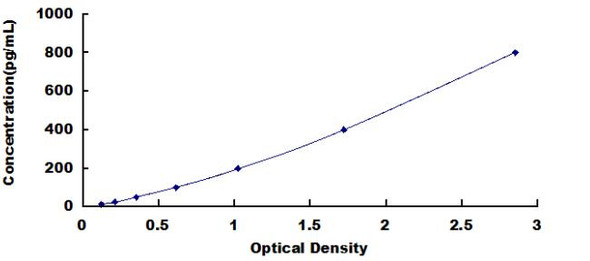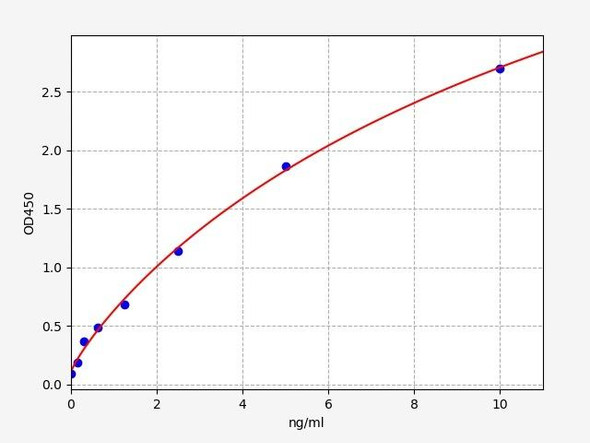Description
Human CK-19/KRT19 (Cytokeratin 19) ELISA Kit
The Human CK-19 (KRT19, Cytokeratin 19) ELISA Kit is specially designed for the accurate measurement of CK-19 levels in human biological samples such as serum, plasma, and cell culture supernatants. With high sensitivity and specificity, this kit delivers reliable and reproducible results, making it an excellent tool for a variety of research applications.CK-19, also known as Cytokeratin 19 or KRT19, is a key protein found in epithelial cells and is involved in maintaining cell structure and function.
Elevated levels of CK-19 have been linked to various cancers, including breast, lung, and liver cancer, making it a valuable biomarker for cancer research and diagnosis.Whether studying cancer biology, biomarker discovery, or therapeutic development, the Human CK-19 ELISA Kit provides researchers with a powerful tool to accurately measure CK-19 levels and advance their scientific understanding in the field.
| Assay type: | Sandwich |
| Format: | 96T |
| Assay time: | 4.5h |
| Reactivity: | Human |
| Detection Method: | Colormetric |
| Detection Range: | 62.50-4000 pg/mL |
| Sensitivity: | 37.50 pg/mL |
| Sample Volume Required Per Well: | 100µL |
| Sample Type: | Serum, plasma and other biological fluids |
| Specificity: | This kit recognizes Human CK-19/KRT19 in samples. No significant cross-reactivity or interference between Human CK-19/KRT19 and analogues was observed. |
This ELISA kit uses Sandwich-ELISA as the method. The micro ELISA plate provided in this kit has been pre-coated with an antibody specific to Human CK-19/KRT19. Standards or samples are added to the appropriate micro ELISA plate wells and combined with the specific antibody. Then a biotinylated detection antibody specific for Human CK-19/KRT19 and Avidin-Horseradish Peroxidase (HRP) conjugate are added to each micro plate well successively and incubated. Free components are washed away. The substrate solution is added to each well. Only those wells that contain Human CK-19/KRT19, biotinylated detection antibody and Avidin-HRP conjugate will appear blue in color. The enzyme-substrate reaction is terminated by adding Stop Solution and the color turns yellow. The optical density (OD) is measured spectrophotometrically at a wavelength of 450 nm ± 2 nm. The OD value is proportional to the concentration of Human CK-19/KRT19. The concentration of Human CK-19/KRT19 in samples can be calculated by comparing the OD of the samples to the standard curve.
| UniProt Protein Function: | Function: Involved in the organization of myofibers. Together with KRT8, helps to link the contractile apparatus to dystrophin at the costameres of striated muscle. Ref. 14 |
| UniProt Protein Details: | Subunit structure: Heterotetramer of two type I and two type II keratins. Interacts with PNN and the actin-binding domain of DMD. Interacts with HCV core protein. Ref. 13 Ref. 14 Tissue specificity: Expressed in a defined zone of basal keratinocytes in the deep outer root sheath of hair follicles. Also observed in sweat gland and mammary gland ductal and secretory cells, bile ducts, gastrointestinal tract, bladder urothelium, oral epithelia, esophagus, ectocervical epithelium (at protein level). Expressed in epidermal basal cells, in nipple epidermis and a defined region of the hair follicle. Also seen in a subset of vascular wall cells in both the veins and artery of human umbilical cord, and in umbilical cord vascular smooth muscle. Observed in muscle fibers accumulating in the costameres of myoplasm at the sarcolemma in structures that contain dystrophin and spectrin. Ref. 2 Ref. 4 Ref. 14 Developmental stage: Present in hair follicles at all stages of development. Ref. 4 Domain: This keratin differs from all other IF proteins in lacking the C-terminal tail domain. Miscellaneous: There are two types of cytoskeletal and microfibrillar keratin: I (acidic; 40-55 kDa) and II (neutral to basic; 56-70 kDa). Sequence similarities: Belongs to the intermediate filament family. |
| NCBI Summary: | The protein encoded by this gene is a member of the keratin family. The keratins are intermediate filament proteins responsible for the structural integrity of epithelial cells and are subdivided into cytokeratins and hair keratins. The type I cytokeratins consist of acidic proteins which are arranged in pairs of heterotypic keratin chains. Unlike its related family members, this smallest known acidic cytokeratin is not paired with a basic cytokeratin in epithelial cells. It is specifically expressed in the periderm, the transiently superficial layer that envelopes the developing epidermis. The type I cytokeratins are clustered in a region of chromosome 17q12-q21. [provided by RefSeq, Jul 2008] |
| UniProt Code: | P08727 |
| NCBI GenInfo Identifier: | 311033484 |
| NCBI Gene ID: | 3880 |
| NCBI Accession: | P08727. 4 |
| UniProt Secondary Accession: | P08727,Q5XG83, Q6NW33, Q7L5M9, Q96A53, Q96FV1, Q9BYF9 Q9P1Y4, B2R874, |
| UniProt Related Accession: | P08727 |
| Molecular Weight: | 44,106 Da |
| NCBI Full Name: | Keratin, type I cytoskeletal 19 |
| NCBI Synonym Full Names: | keratin 19 |
| NCBI Official Symbol: | KRT19 |
| NCBI Official Synonym Symbols: | K19; CK19; K1CS |
| NCBI Protein Information: | keratin, type I cytoskeletal 19; CK-19; keratin-19; cytokeratin 19; cytokeratin-19; keratin, type I, 40-kd; 40-kDa keratin intermediate filament |
| UniProt Protein Name: | Keratin, type I cytoskeletal 19 |
| UniProt Synonym Protein Names: | Cytokeratin-19; CK-19; Keratin-19 |
| Protein Family: | Keratin |
| UniProt Gene Name: | KRT19 |
| UniProt Entry Name: | K1C19_HUMAN |
As the OD values of the standard curve may vary according to the conditions of the actual assay performance (e. g. operator, pipetting technique, washing technique or temperature effects), the operator should establish a standard curve for each test. Typical standard curve and data is provided below for reference only.
| Concentration (pg/mL) | O.D | Average | Corrected |
| 4000 | 2.3 2.332 | 2.316 | 2.23 |
| 2000 | 1.626 1.636 | 1.631 | 1.545 |
| 1000 | 0.951 0.929 | 0.94 | 0.854 |
| 500 | 0.494 0.516 | 0.505 | 0.419 |
| 250 | 0.28 0.264 | 0.272 | 0.186 |
| 125 | 0.193 0.169 | 0.181 | 0.095 |
| 62.50 | 0.133 0.137 | 0.135 | 0.049 |
| 0 | 0.083 0.089 | 0.086 | -- |
Precision
Intra-assay Precision (Precision within an assay): 3 samples with low, mid range and high level Human CK-19/KRT19 were tested 20 times on one plate, respectively.
Inter-assay Precision (Precision between assays): 3 samples with low, mid range and high level Human CK-19/KRT19 were tested on 3 different plates, 20 replicates in each plate.
| Intra-assay Precision | Inter-assay Precision | |||||
| Sample | 1 | 2 | 3 | 1 | 2 | 3 |
| n | 20 | 20 | 20 | 20 | 20 | 20 |
| Mean (pg/mL) | 209.92 | 451.67 | 1959.03 | 220.56 | 450.39 | 1983.49 |
| Standard deviation | 13.35 | 20.33 | 73.86 | 12.99 | 25.18 | 69.22 |
| C V (%) | 6.36 | 4.50 | 3.77 | 5.89 | 5.59 | 3.49 |
Recovery
The recovery of Human CK-19/KRT19 spiked at three different levels in samples throughout the range of the assay was evaluated in various matrices.
| Sample Type | Range (%) | Average Recovery (%) |
| Serum (n=5) | 89-103 | 94 |
| EDTA plasma (n=5) | 86-100 | 92 |
| Cell culture media (n=5) | 92-104 | 98 |
Linearity
Samples were spiked with high concentrations of Human CK-19/KRT19 and diluted with Reference Standard & Sample Diluent to produce samples with values within the range of the assay.
| Serum (n=5) | EDTA plasma (n=5) | Cell culture media (n=5) | ||
| 1:2 | Range (%) | 91-103 | 92-105 | 98-113 |
| Average (%) | 98 | 98 | 104 | |
| 1:4 | Range (%) | 89-104 | 84-95 | 82-97 |
| Average (%) | 95 | 88 | 88 | |
| 1:8 | Range (%) | 88-102 | 85-97 | 86-97 |
| Average (%) | 93 | 90 | 92 | |
| 1:16 | Range (%) | 89-100 | 85-99 | 83-96 |
| Average (%) | 95 | 91 | 89 |
An unopened kit can be stored at 4°C for 1 month. If the kit is not used within 1 month, store the items separately according to the following conditions once the kit is received.
| Item | Specifications | Storage |
| Micro ELISA Plate(Dismountable) | 8 wells ×12 strips | -20°C, 6 months |
| Reference Standard | 2 vials | |
| Concentrated Biotinylated Detection Ab (100×) | 1 vial, 120 µL | |
| Concentrated HRP Conjugate (100×) | 1 vial, 120 µL | -20°C(shading light), 6 months |
| Reference Standard & Sample Diluent | 1 vial, 20 mL | 4°C, 6 months |
| Biotinylated Detection Ab Diluent | 1 vial, 14 mL | |
| HRP Conjugate Diluent | 1 vial, 14 mL | |
| Concentrated Wash Buffer (25×) | 1 vial, 30 mL | |
| Substrate Reagent | 1 vial, 10 mL | 4°C(shading light) |
| Stop Solution | 1 vial, 10 mL | 4°C |
| Plate Sealer | 5 pieces | |
| Product Description | 1 copy | |
| Certificate of Analysis | 1 copy |
- Set standard, test sample and control (zero) wells on the pre-coated plate and record theirpositions. It is recommended to measure each standard and sample in duplicate. Note: addall solutions to the bottom of the plate wells while avoiding contact with the well walls. Ensuresolutions do not foam when adding to the wells.
- Aliquot 100µl of standard solutions into the standard wells.
- Add 100µl of Sample / Standard dilution buffer into the control (zero) well.
- Add 100µl of properly diluted sample (serum, plasma, tissue homogenates and otherbiological fluids) into test sample wells.
- Cover the plate with the sealer provided in the kit and incubate for 90 min at 37°C.
- Aspirate the liquid from each well, do not wash. Immediately add 100µL of BiotinylatedDetection Ab working solution to each well. Cover the plate with a plate seal and gently mix. Incubate for 1 hour at 37°C.
- Aspirate or decant the solution from the plate and add 350µL of wash buffer to each welland incubate for 1-2 minutes at room temperature. Aspirate the solution from each well andclap the plate on absorbent filter paper to dry. Repeat this process 3 times. Note: a microplatewasher can be used in this step and other wash steps.
- Add 100µL of HRP Conjugate working solution to each well. Cover with a plate seal andincubate for 30 min at 37°C.
- Aspirate or decant the solution from each well. Repeat the wash process for five times asconducted in step 7.
- Add 90µL of Substrate Reagent to each well. Cover with a new plate seal and incubate forapproximately 15 min at 37°C. Protect the plate from light. Note: the reaction time can beshortened or extended according to the actual color change, but not by more than 30min.
- Add 50 µL of Stop Solution to each well. Note: Adding the stop solution should be done inthe same order as the substrate solution.
- Determine the optical density (OD value) of each well immediately with a microplate readerset at 450 nm.










